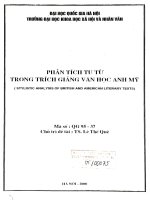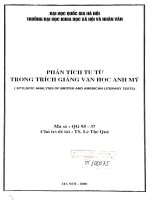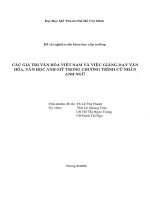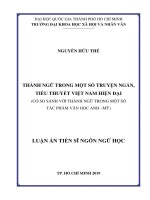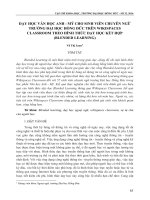En16 văn học anh mỹ bài 15
Bạn đang xem bản rút gọn của tài liệu. Xem và tải ngay bản đầy đủ của tài liệu tại đây (146.57 KB, 7 trang )
<span class="text_page_counter">Trang 1</span><div class="page_container" data-page="1">
<b>HANOI OPEN UNIVERSITYMID -TERM TEST ON ENGLISH AND AMERICANLITERATURE </b>
<small>FOR STUDENTS OF ENGLISH (No 2)</small>Subject Code: EN16
Full name: ……… ……...
Date of birth: ………...Group: ……… ……….No . 2
<b>I. Answer the following questions: (50 points )</b>
1. What three languages were spoken in England in the 11th - 13th centuries, and whom were they spoken by? Mention some reasons.
2. What is a romance, a fabliaux, a bestiaria? In what language were they written?(The file sent will be named after each student’s name. Plagiarism will lead to failure)1.
Three main languages spoken in England in the 11th - 13th centuries: Middle English, Anglo-Norman (or French) and Latin.
- Middle English: In 1066 William the Conqueror, the Duke of Normandy (part of modem Erance), invaded and conquered England. The new conquerors (called the Normans) brought with them a kind of Erench, which became the language of the Royal Court, and the ruling and business classes. For a period there was a kind of linguistic class division, where the lower classes spoke English and the upper classes spoke Erench. In the 14th century English became dominant in Britain again, but with many French words added. This language is called Middle English. It was the language of the great poet Chaucer (c1340 — 1400), but it would still be difficult for native English speakers to understand today.
- Anglo-Norman (or French): Anglo-Norman, also known as Anglo-Norman Erench. Anglo-Norman had emerged as a distinct đialect of French after the Norman Conquest in 1066 established a French-speaking aristocracy in English. It was spoken in the law courts, schools, and universities and, in due course, in at least some sections of the gentry and the growing bourgeoisie. Private and commercial correspondence was carried out in Anglo-Norman or Anglo-Erench though Anglo-Norman and Anglo- French were eventually
</div><span class="text_page_counter">Trang 2</span><div class="page_container" data-page="2">eclipsed by modern English, they had been used widely enough to influence English vocabulary permanently.
- Latin: English was slow to take over as the language of government, law, andbureaucracy, đespite the fact that by a law passed in 1362 all legal pleadings had tobe in English. However, most other types of official documents continued to be written in Latin, such as the manor court roll (MS 66/1) shown on the previous page of this unit. It was not until the mid-sixteenth century that English began to appear in manorial records, and even then it was often only used to record
presentments spoken in that language at the meeting of the manor court. It was a similar situation in the records of the Nottingham Archdeaconry court. In
depositions written in 1610, the words spoken by ordinary people are written in English, as they said them, but the rest of the document explaining the caseis in Latin.
- Rentals and accounts from landed estates are rare in English before the beginning of the sixteenth century. Most title deeds were also written in Latin until the sixteenth century and even later.
- The Catholic church used Latin in its services, so all liturgical books were written in this language until the Reformation in the sixteenth century. The theologian John 'Wycliffe began to translate the Bible into English in the late fourteenth century, but the Lollard movement with which he was associated was persecuted by the authorities, so late medieval Bibles in English are rare.2.
Romance :
- In the strictest academic terms, a romance is a narrative genre in literature thatinvolves a mysterious, adventurous, or spiritual story line where the Íocus is on a quest that involves bravery and strong values, not always a love interest. However,modern definitions of romance also include stories that have a relationship issue asthe main focus.
</div><span class="text_page_counter">Trang 3</span><div class="page_container" data-page="3">- Types of Romance: Gothic (popular Gothic novels still read by many high school students today are classics such as: Jane Eyre by Charlotte Bronte, Wuthering Heights by Emily Bronte, Frankenstein by Mary Shelley); historical(The Last of the Mohicans by James Fenimore Cooper, Rob Roy by Sir Walter Scott); contemporary/Modern (there can be: comedy-romance, tragic-romance, satire-romance, serious romance)
- Fabliau (the plural form is fabliaux) is a comical fable told in verse. They wereall the rage in the 12th and 13th centuries. Fabliaux were typically told by jongleurs (professional storytellers/public entertainers in France). The short stories were known for their colorful and comical observations on life, sort of like a cynical and harsh Middle Age version of Jerry Seinfeld. The stories took comedic shots at things like religion, the sanctity of marriage, and the treatmentof women.
- The fabliau style was simple and straightforward. The narratives were always situated in present day and the characters were from the middle or lower classes. Fabliaux made fun of everyday life. The plots were often centered on women with large sexual appetites and men who were ignorant fools. There was typically some sort of scam or practical joke in the narrative and trickery was usually successful.
- There are about 150 surviving fabliaux from various jongleurs from the over 200 or so years that the form was popular in medieval literature. However, one of the most revered fabliaux writers in the history of storytelling was Geoffrey Chaucer.
- Bestiary, a literary genre in the European Middle Ages consisting of a collection of stories, each based on a description of certain qualities of an animal, pÏant, or even stone. The stories presented Christian allegories for moral and religious instruction and admonition.
- The numerous manuscripts of medieval bestiaries ultimately are derived from the Greek Physiologus, a text compiled by an unknown author before the
</div><span class="text_page_counter">Trang 4</span><div class="page_container" data-page="4">middle of the 2<small>nd</small> century AD. It consists of stories based on the “facts” of natural science as accepted by someone called Physiologus (Latin:
“Naturalist”), about whom nothing further is known, and from the compiler”s own religious ideas.
- The Physiologus consists of 48 sections, each dealing with one creature, plant, or stone and each linked to a biblical text. The popularity of the Physiologus, which circulated in the early Middle Ages only less widely than the Bible, is clear from the existence of many early translations. It was translated into Latin (first in the 4th or 5<small>th</small> century), Ethiopian, Syriac, Arabic, Coptic, and
Armenian. Early translations from Greek also were made into Georgian and into Slavic languages.
- Translations were made from Latin into Anglo-Saxon before 1000. In the 11<small>th</small>
century, an otherwise unknown Thetbaldus made a metrical Latin version of 13sections of the Physiologus. This was translated, with alterations, in the only surviving Middle English Bestiary, dating from the 13th century. It, and other lost Middle English and Anglo-Norman versions, influenced the development of the beast fable. Early translations into Elemish and German influenced the satiric beast epic. Bestiaries were popular in France and the Low Countries in the 13th century, and a 14th-century French Bestiaire damour applied the allegory to love. An Iralian translation of the Physiologus, khown as the Bestiario Toscano, was made in the 13th century.
<b>II. Comments (50 points ) </b>
Write what you know about the life and works of Geoffrey Chaucer - The founder of English realism
Geoffrey Chaucer is one of the greatest poets of England. He is known to be the father of English poetry. This does not mean that there was no poetry, or poets in England before him. But before Chaucer, there was no National language. There were merely a number of regional languages. Chaucer used one of these languages, East
</div><span class="text_page_counter">Trang 5</span><div class="page_container" data-page="5">Midland. By the force of his genius, he raised it to the level of the national language of England. He was, therefore, both the father of English poetry and the father of the English language. He is the first national poet of England. Geoffrey Chaucer was the greatest writer of the 14” century. He was bom around 1343 in London and đied October 25, 1400, in London, England, and was the first to be buried in Westminster Abbey”s Poet's Corner. His father and grandfather were both London wine merchants and before that, for several generations, the family had been merchants in Ipswich. Although the Chaucers were not of noble birth, they were extremely well-to-do.
While records concerning the lives of his contemporaries William
Langland and the Gawain Poet are practically non-existent, since Chaucer was a public servant his official life is very well documented, with nearly five hundred written items testifying to his career. The first of the "Chaucer Life Records" appears in 1357, in the household accounts of Elizabeth de Burgh, the Countess of Ulster, when he became the noblewoman's page through his father's connections, a common medieval form of apprenticeship for boys into knighthood or prestige appointments. The countess was married to Lionel of Antwerp, 1st Duke of Clarence, the second surviving son of the king, Edward III, and the position brought the teenage Chaucer into the close court circle, where he was to remain for the rest of his life. In 1359, the early stages of the Hundred Years' War, Edward III invaded France and Chaucer travelled with Lionel of Antwerp, Elizabeth's husband, as part of the English army. Around 1366, Chaucer married Philippa (de) Roet. She was a lady-in-waiting to Edward III's queen, Philippa of Hainault, and a sister of Katherine Swynford, who later (c. 1396) became the third wife of John of Gaunt. It is uncertain how many children Chaucer and Philippa had, but three or four are most commonly cited. His son, Thomas Chaucer, had an illustrious career, as chief butler to four kings, envoy to France, and Speaker of the House of Commons. Thomas's daughter, Alice, married the Duke of Suffolk. Thomas's great-grandson (Geoffrey's great-great-grandson), Johnde la Pole, Earl of Lincoln, was the heir to the throne designated by Richard III before he was deposed. Geoffrey's other children probably included Elizabeth Chaucy, a nun at Barking Abbey, Agnes, an attendant at Henry IV's coronation; and another son, Lewis Chaucer. Chaucer's "Treatise on the Astrolabe" was written for Lewis.
Chaucer seems to have respected and admired Christians and to have been one himself, though he also recognised that many people in the church were venal and
</div><span class="text_page_counter">Trang 6</span><div class="page_container" data-page="6"><i>corrupt. He wrote in Canterbury Tales, "now I beg all those that listen to this little </i>
treatise, or read it, that if there be anything in it that pleases them, they thank our LordJesus Christ for it, from whom proceeds all understanding and goodness."
Chaucer's first major work was The Book of the Duchess, an elegy for Blancheof Lancaster who died in 1368. Two other early works were Anelida and
Arcite and The House of Fame. He wrote many of his major works in a prolific periodwhen he held the job of customs comptroller for London (1374 to 1386).
His Parlement of Foules, The Legend of Good Women, and Troilus and Criseyde all date from this time. It is believed that he started The Canterbury Tales in the 1380s.
Chaucer also translated Boethius' Consolation of Philosophy and The Romanceof the Rose by Guillaume de Lorris (extended by Jean de Meun). Eustache
Deschamps called himself a "nettle in Chaucer's garden of poetry". In 1385, Thomas Usk made glowing mention of Chaucer, and John Gower also lauded him.
Chaucer's Treatise on the Astrolabe describes the form and use of
the astrolabe in detail and is sometimes cited as the first example of technical writing in the English language, and it indicates that Chaucer was versed in science in
addition to his literary talents. The equatorie of the planetis is a scientific work similarto the Treatise and sometimes ascribed to Chaucer because of its language and
handwriting, an identification which scholars no longer deem tenable.
Perhaps the chief characteristics of Chaucer’s works are their variety in subject matter, genre, tone, and style and in the complexities presented concerning the human pursuit of a sensible existence. Yet his writings also consistently reflect an all-
pervasive humour combined with serious and tolerant consideration of important philosophical questions. From his writings Chaucer emerges as poet of love, both earthly and divine, whose presentations range from lustful cuckoldry to spiritual unionwith God. Thereby, they regularly lead the reader to speculation about man’s relation both to his fellows and to his Maker, while simultaneously providing delightfully entertaining views of the frailties and follies, as well as the nobility, of mankind.
<b>Một số yêu cầu:</b>
<i>+ Sinh viên nộp file word lên hệ thống </i>
</div><span class="text_page_counter">Trang 7</span><div class="page_container" data-page="7"><i>+ Ghi rõ mã đề trong bài làm.</i>
</div>


